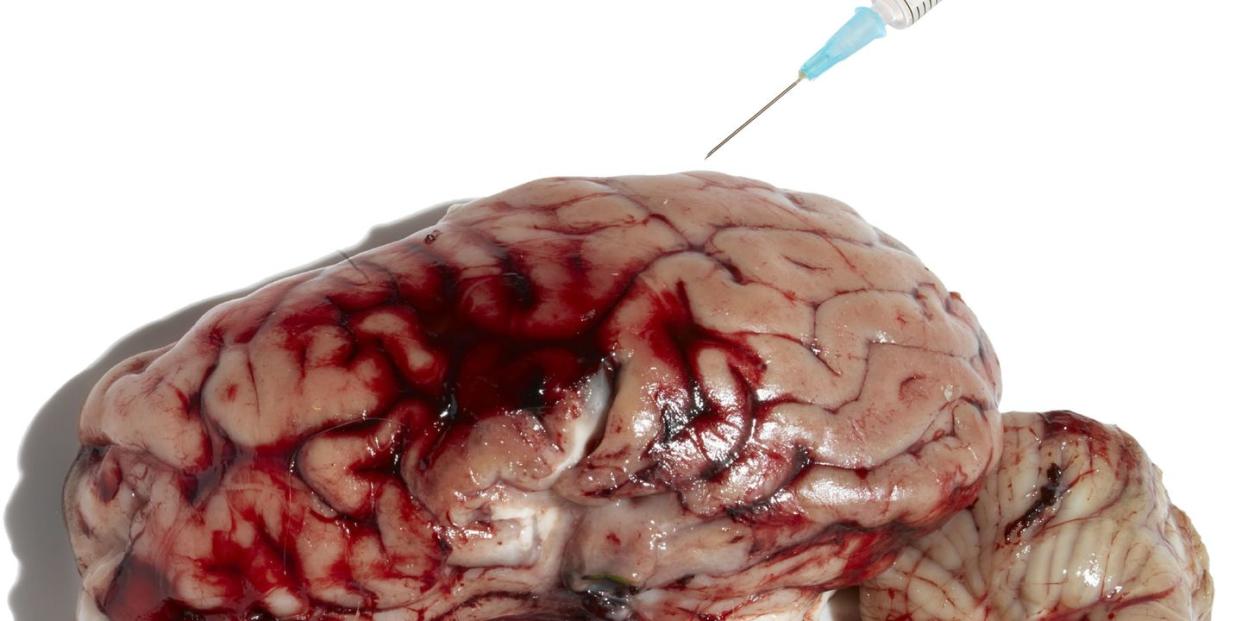A Rush of Blood to the Head: The Links Between Steroids and Ill Mental Health

Cesar Sayoc never thought that he would be caught for sending pipe bombs to prominent US Democrats, including Barack Obama, Hillary Clinton and Robert De Niro, because he felt invincible. He proudly texted his steroids dealer a link to a New York Times story about the suspicious package that he had sent to billionaire Democrat donor George Soros. It wasn’t until Sayoc saw the FBI manhunt for the ‘mail bomber’ on TV that he realised: that was him.
A small, stuttering child who was targeted by bullies and sexually abused at a Catholic boarding school, Sayoc started taking steroids when he was 15 in the hope that he would stop being victimised. Later, fellow steroids users inducted him into the exotic dancing industry, where he worked as a bouncer and entertainer, touring the US. By 2012, he was living in a van in Florida, delivering pizza, using steroids on and off and listening to Donald Trump’s motivational tapes.
In 2018, aged 56, Sayoc increased his dosage to bulk up for a doorman job at a gentlemen’s club. He became obsessed with the idea that liberals were targeting him. And shortly before the November mid-term elections, he made what his defence called ‘the biggest mistake of his life’. Sayoc had been arrested a few times for shoplifting during his decade of van living, and he had once threatened to blow up a power company if it cut off electricity to his ill-fated dry-cleaning business. But he had never done anything like this. And he never would have, testified Dr Harrison G Pope Jr, if he hadn’t been using steroids. That, and the reality that the bombs weren’t designed to explode (though they still could have), contributed to Sayoc’s sentence of 20 years, which his defence considered lenient.
Dangerous Minds
Pope is a professor of psychiatry at Harvard Medical School and co-founder and director of the Biological Psychiatry Laboratory at its Maclean teaching hospital. He’s also arguably the world’s foremost expert on anabolic-androgenic steroids. Since the 1980s, when steroids spread to the general population in the US (as they did in the 1990s in the UK), Pope has testified in 30 or more cases and has been involved in some capacity in around a hundred more. And he guesses that there might be many hundreds of cases in the US alone in which someone did something ‘under the influence of steroids’ but the potential role of the drugs was not considered.
Being drunk isn’t a viable defence for getting into a fight, says Pope, because the behavioural effects of alcohol are common knowledge. However, the behavioural effects of steroids – euphoria, irritability, aggression, hyperactivity, impaired judgement, violence, depression, suicidal ideation, paranoia and delusions of grandeur – are not.
Hypomanic (mild) or manic (not mild) episodes on steroids are not common, says Pope. For 90% of users, he estimates that symptoms are ‘very modest’. But in others, the effects are ‘fairly pronounced’. In some cases, for reasons that science hasn’t yet figured out because steroids and their users are still relatively young – the majority are under 50 – the outcome can be ‘a veritable Jekyll and Hyde transformation’.
A number of historic cases demonstrate this abrupt shift in temperament. In the 1990s, Pope testified in the case of a previously timid 16-year-old boy, who started using steroids at the age 14, broke into his school and trashed his bedroom in a rage. After a fifth, larger cycle, he started to suspect that his 14-year-old girlfriend was cheating on him. He drank a few beers, lured her into the local woods and stabbed her to death. The jury didn’t accept that steroids might have been a mitigating factor in his actions, and he was sentenced
to life without parole.
The public perception of ‘’roid rage’ – a colloquial, obviously unscientific term – is of an impulsive blow-up. But steroids can also kindle an obsessive slow burn. In one case, a prison officer responded to an innocent joke by a female store clerk by coming back the next day and forcing the woman into his car. When she tried to escape, he shot her in the back, paralysing her from the waist down. His is one of three reported cases of a steroid-using identical twin developing psychiatric symptoms that the non-using brother didn’t.
Wrestler Chris Benoit was already known to the US Drug Enforcement Agency for buying large quantities of steroids when, in 2003, he killed his wife, his seven-year-old son and himself. WWE impresario Vince McMahon said that it was ‘impossible’ that Benoit’s actions were influenced by steroids. ‘This was an act of deliberation over a three-day period, not an impulse.’ (McMahon was indicted in 1993 for allegedly conspiring to distribute steroids to his wrestlers but was acquitted.)
There’s no way to know why Benoit did what he did: his body contained alcohol, as well as 10 times the normal level of testosterone, while his brain showed severe chronic traumatic encephalopathy, a progressive brain condition caused by repeated blows to the head. But his is one of many high-profile cases – Norwegian mass-murderer Anders Breivik, Orlando nightclub gunman Omar Mateen, notorious Newcastle killer Raoul Moat – in which the potential of steroids to actuate premeditated violence has been under-appreciated.
The Difference In The Dose
The theory is not new. In a 1987 paper titled ‘Bodybuilder’s Psychosis’, Pope and colleagues reported the first case series of apparently steroid-induced psychiatric effects, including a man who experienced religious delusions and another who bought a scrap car and deliberately crashed it into a wall while his buddy filmed. The idea that steroids could cause such behaviour was met with ‘quite a lot of incredulity’. But the researchers soon received calls from attorneys across the US whose clients had committed violent crimes on steroids wildly out of their previous character.
It took about 20 years and several placebo-controlled, double-blind studies in which neither the investigators nor the subjects knew who was getting the genuine juice for the scientific community to accept the effects of steroids on the mind. In one study, a subject became so aggressive that he requested to be placed in a seclusion room. In another study, a subject was removed because he was frightening his colleagues at work.
The average male testes manufacture 50mg of testosterone, nature’s own steroid, per week. Steroid users typically take anywhere between 300mg and 5,000mg – as much as 100 times normal levels – of testosterone, or a synthetic equivalent. Studies suggest that at doses of 300mg per week, psychiatric effects are rare. At 600mg per week, they become more common, affecting around 5% to 10% of subjects. In those taking above 1,000mg per week, that rises to 20%.
It’s important to note that these studies administered doses of steroids far lower than what users commonly take. Not only that, study subjects are pre-screened for psychiatric conditions or criminal behaviour. That doesn’t happen in the real world, where users frequently ‘stack’ multiple steroids and consume alcohol or other drugs. And like other drugs, illicitly procured steroids may not be as advertised.
And these are just the ‘pronounced’ reactions. In a study conducted by Pope and colleagues, a subgroup of subjects who played a game designed (unknown to them) to provoke hostile reactions displayed ‘strikingly and significantly higher levels of aggression’ on 600mg of testosterone compared with a placebo. Other studies have shown increased aggression and decreased ability to override impulsive responses on single-dose testosterone – again at lower doses than steroid users typically take.

Expanded to include such minor effects, says Pope, the number of cases ‘could indeed be a very large number of people’. Consider that it’s currently estimated that roughly one in 16 gym-going men in the UK uses steroids. But there is no way to get a truly representative sample of users, who can be reluctant to admit to their steroids habit, or an accurate account of behaviour changes, because they may not recognise that their behaviour has changed. Anosognosia – not knowing you’re ill – is common in psychiatric disorders and has been observed to a lesser degree in steroids users, who often don’t realise until they’re told. Or they get into trouble.
Highs and Lows
’Roid rage is ‘the classic example’ of how steroids can affect the mind, says Joseph Kean, deputy services manager at the Bradford New Directions drug and alcohol recovery service, who has published papers with Pope (or ‘Skip’, as he calls him) and other researchers. The phenomenon isn’t universal. Kean knows a bodybuilder who ‘smashes’ steroids, yet is so placid that if you punched him in the face, he (probably) wouldn’t react. But users often report getting tetchy. Kean once found himself ‘ripping into’ a man in an Asda car park after a couple of shots of trenbolone, while thinking: ‘That isn’t me at all.’ Luckily, he was able to recognise it and walk away.
For his part in smuggling heroin, amphetamines, cocaine and cannabis worth £20m, Kean was sentenced in 2003 to 10 years in prison and served five. Inside, he started lifting weights, but he didn’t start using steroids until he transferred to Ranby, a category-C prison in Nottinghamshire, and played for its rugby team in a local league (‘obviously no away games’). When he injured his back, a staff member offered him a ‘jab’. Two weeks and four injections later, Kean was playing again, as good as new.
And he felt good. He walked around with his chin up and chest out: a sizeable benefit in prison, which is ‘probably the most testosterone-fuelled environment that exists’. He went into every tackle knowing that he had to smash the opposition player off his feet or the 150 prisoners watching would think he was ‘a vulnerable little twerp’. Kean used steroids a number of times while inside, and for a short period after release.
Twenty years ago, says Kean, steroids were seen as a ‘functional’ drug, taken to make muscles grow bigger. Now, the conversation is more around their psychoactive qualities – not only talking about the negative effects of steroids on the mind but acknowledging that users take them for the same reason they would any drug, or drink alcohol: ‘Because they enjoy doing it and there’s a positive effect – at the start.’
The motivations for steroid use have ‘changed considerably’. Kean and his colleagues see lads who actively want to be more aggressive and go out fighting in town, fuelled by ‘12 pints, an eighth of coke and a couple of thousand milligrams a week’.
Kean and his colleagues also see police officers who use steroids to level the playing field with the ‘monsters’ in town, to not only be bigger and stronger but to feel more secure. And it’s not uncommon, he says, for current and former servicemen to self-medicate with steroids for PTSD. Others use steroids for depression, or just general psychological well-being, sometimes with the excuse of low testosterone, for long periods in small doses with little interest in big muscles.
But, as Kean says, nobody has one line of coke, one pint, one biscuit. If steroid users feel good on a certain dosage, then, they often reason, they’ll feel even better on a higher dosage: ‘It goes on and on and on and on.’
At The Sharp End

Men’s brains respond to the flood of steroids from outside their bodies by disrupting gonadotropic hormones. In turn, their testes stop producing testosterone and sperm cells and shrink. When the external supply of steroids dries up, especially abruptly and after prolonged use, testosterone production doesn’t restart immediately. (The scientifically unproven practice of taking cycles that taper up and down with periods off is partly to avoid this.) ‘Hypogonadism’ can resolve in weeks, or persist for months or years, and cause erectile dysfunction, libido loss and depression. Kean recently warned a young man coming off steroids that he’d feel ‘like absolute fucking shit’.
Depression during steroid withdrawal is only thought to afflict roughly 10% of users but can still be severe enough to cause suicide. The temptation to resume use is strong, and one of the ‘triple threat’ of pathways to dependence, along with not wanting to lose gains that can’t be achieved without steroids and their hedonic properties.
Steroids don’t deliver a quick hit like ‘classical’ drugs of abuse, but users report feelings of boosted self-confidence or invincibility. (Male hamsters will self-inject testosterone, via a nose poke-hole, to death.) Kean and his colleagues have to use the same interventions for steroids as they do for heroin or crack.
Steroids grow muscles, but they shrink brains. Investigating whether the effects of steroids on the mind could represent more permanent structural changes in the brain, the Anabolic-Androgenic Steroids Research Group at Oslo University Hospital found that users with more than one year of cumulative exposure had smaller brain volumes than a weightlifting control group. The biggest differences were in total grey matter volume and the cerebral cortex, which was significantly thinner in several areas.
Those differences corresponded to mental performance. Even after correcting for age and education, steroid users displayed poorer functioning across working memory, speed of processing and problem solving. Again, there was a dose-response effect: 36% of users with less than five years of exposure reported memory problems; with 10 years or more, over 50%.
‘I would be worried,’ says co-author Dr Astrid Bjørnebekk, with the caveat that she and her colleagues would need to study an elderly population of steroid users to get the full picture. Even if the reduced cognitive performance doesn’t affect the lives of users when they are between 35 and 40, the concern is that memory problems may worsen with age. And the users in her study already had a higher ‘brain age’ compared with healthy contemporaries.
In another study, Bjørnebekk and her colleagues found dependent steroid users had even older brain ages than non-dependent users. They also had thinner cortexes in several areas, with some of the ‘most profound’ effects located in the regions responsible for impulse control and emotional processing.
Lasting Damage
Whether the steroid-induced brain shrinkage is permanent is, says Bjørnebekk, ‘a bit difficult to answer’. However, she and her colleagues saw that the effect seemed to persist after cessation of use, albeit this is not so widespread. And conversely, current users had the highest brain age ‘gap’.
Bjørnebekk presented her group’s findings in November last year at the Anabolic Steroids UK online conference, at which Pope also spoke about the ‘looming public health problem’. Imagine, he posited, if smoking had only become widespread in the 1980s, and most of the new smokers were still under the age of 50. There might be the occasional case report of lung cancer or case series of emphysema by now, but we would ‘have no idea of what was about to hit us’.
The negative effects of steroids on the body – persistent hypogonadism, heart problems, toxicity in the liver, kidney and brain – are caused by years of exposure and can take longer still to come home to roost. But the effects of steroids on the mind can be almost immediate. Cases where a user has a ‘really pronounced reaction’ and commits a crime or kills someone, including themselves, are rare, says Pope – but, on the other hand, there’s no way of knowing in advance if you’ll be one of them. And you may not realise until it’s far too late.
You Might Also Like


